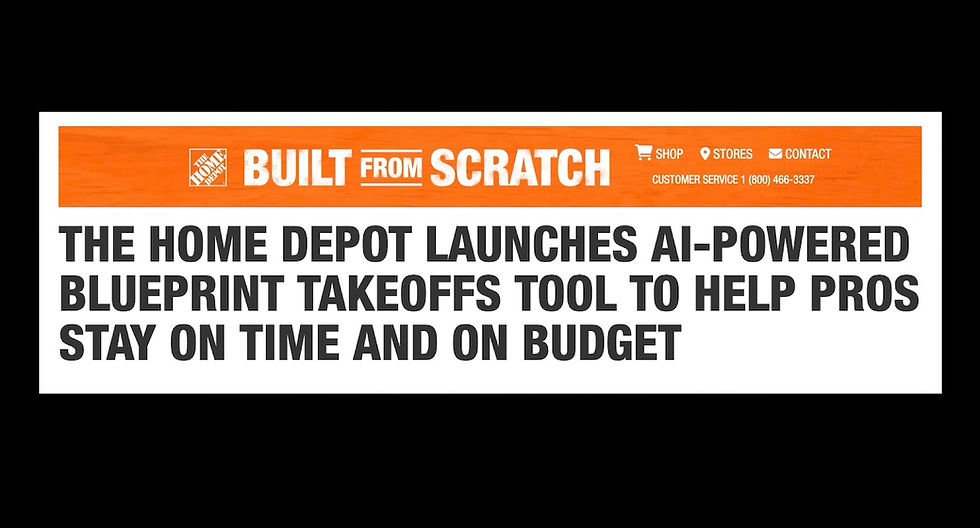In These Hard-to-Predict Times, Stay Positively Nervous--and Close to Your Customers
- Craig Webb

- Nov 8, 2023
- 4 min read
Updated: Nov 9, 2023

We're heading into a 2024 that I believe will be good for most construction supply companies but will be troubling for some depending on where they're located and what they sell.
I've said this is a time to be "positively nervous." Once you compile the many--often contradictory--reports on economic trends, you'll see that one dealer's fortunes could vary dramatically from another's. More than ever, talking regularly with your customers about their prospects (plus looking for new customers) will be a key way for you to gauge what kind of 2024 you'll have.
Let's start with one differentiator: What's your key product? The chart below showing public companies third-quarter reports would lead you to predict that lumber-oriented companies will continue to suffer while non-lumber specialists will do fine.

But this chart is a bit deceiving. Builders FirstSource estimates 9.1 points of its 21.3-point sales decline was because of lower lumber prices. A 13.5-point fall in core organic sales deserves notice, but it's far less painful than 21.3. In addition, you can expect lumber-heavy companies like BFS to see their future year-over-year numbers improve in large part because those quarters won't show the extreme variation in timber prices that we had when comparing 2023 with 2022 results.
Meanwhile, the split between wealthy and not-so-rich Americans is becoming more pronounced in terms of what and how they buy. Expect this to create different selling conditions for, say, dealers with lots of wealthy custom builders and remodelers vs, dealers who cater to people in the lower income brackets.
As the research by Zonda below shows, a higher percentage of lower-income Americans fund roofing jobs and outdoor living projects than you'll find in paying for a new kitchen or room addition.

You can see the impact in the results of some manufacturers that produce home goods. Masonite reported its North American residential section saw a 14% decline in sales. volume. Jeld-Wen's North American sales volume shrank 7%
The rich are still with us, and they're paying up, with cash. According to Redfin, the median sale prices of luxury U.S. homes rose 9% in the third quarter from the year-earlier period to hit $1.1 million. Meanwhile, the median sale price of non-luxury homes rose just 3.3% to $340,000. In addition, 43% of luxury homes were paid for in cash, up from 35% last year. A cash buy means that mortgage rate run-ups don't deter them.
On the other end of the income table, a Farnsworth Group survey of homeowners conducted this fall found a drop in the percentage of people who thought this was a good time to start a project that cost less than $5,000, but not nearly as much a decline in the percentage who felt the same about a project over $5,000. This jibes with reports by groups like the New York Federal Reserve that said Americans' household debt is growing--particularly credit-card debt.
Conclusion: Higher-income households are even more important to homebuilding and remodeling than they've been in the past.
All in all, dealers and construction product manufacturers are likely to end 2023 happier than they felt going into the year. Lots of economists had predicted there would be a recession this year. Instead, the nation's gross domestic product has kept growing; it swelled by a 4.9% annual rate in the third quarter.
Rather than thinking the worst is behind them, however, some executives are just shifting their early 2023 angst to early 2024.
"In February 2023, we advised that 2023 would not be a smooth year with business slowing in the second half and perhaps a rate drop in Q4," Universal Forest Products CEO Matt Missad told analysts. "... I now believe we are off on our prediction by six months or so, and that the slowdown will occur in 2024 and rate decreases are more likely to occur then as well."
One way to judge the economy is to track how much demand there is to move goods. By that measure, softness persists in the truckload market, Ryder's State of the Industry report for November says. That amount charged to carry goods on routes such as Los Angeles to Dallas and Chicago to Atlanta are down 7% to 10% from a year ago.
Meanwhile, Maersk, the world's second-largest ocean carrier, announced it is cutting 2,500 jobs by December on top of the 6,500 people it has laid off since Jan. 1. That cuts its global headcount by 9%. "This is not a diet. This is a rest of the baseline," Freightwaves quoted Maersk CEO Vincent Clerc as saying.
And yet: Freightwaves also has reported that U.S. imports of shipping containers rose 4% year-over-year in October year and are 11.5% higher than before COVID in October 2019. It could be that a worldwide company like Maersk is having problems more because of setbacks in Europe and Asia than in North America.
Turning back to homebuilding, we have reached the point where 30.6% of all single-family homes in the U.S. that are for sale are products of new construction. That's the highest share ever. High mortgage rates are reducing the number of existing homes for sale, and big production builders are keeping themselves busy by offering deals that shave a few points off the mortgage rate. Dealers that cater to production builders thus are continuing to get busy, while dealers that sell more to small builders (who can't afford the mortgage buydown) could see bigger problems the longer 8% mortgage rates last. Then again, the super-wealthy don't worry about mortgages, so builders who have customers who pay for homes with cash will be less affected.
At a time when higher interest rates have made borrowing more painful, public companies are making a point of telling how strong their balance sheets are. Private companies are wise to think the same. This year and probably next are times when the bottom line matters more than the top line.
Here's one more positive chip: Your costs for processing debit cards could drop as a result of a move proposed by the Federal Reserve Board to cut the current maximum charge by about one-third. The current cap chargeable per debit card transaction is 21 cents plus one cent for fraud prevention and 0.05% of the transactions amount to cover fraud costs. The Fed wants to cap the fee at 14.4 cents per transaction plus 1.3 cents for fraud prevention and 0.04% of the transaction amount for fraud costs. The Fed estimates that its proposal would cut the cost for processing a $50 debit card transaction to 17.7 cents from 24.5 cents. Studies indicate processors' actual cost is about 3.9 cents.






Comments